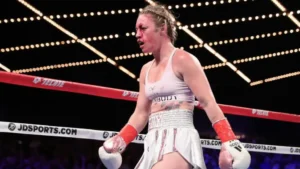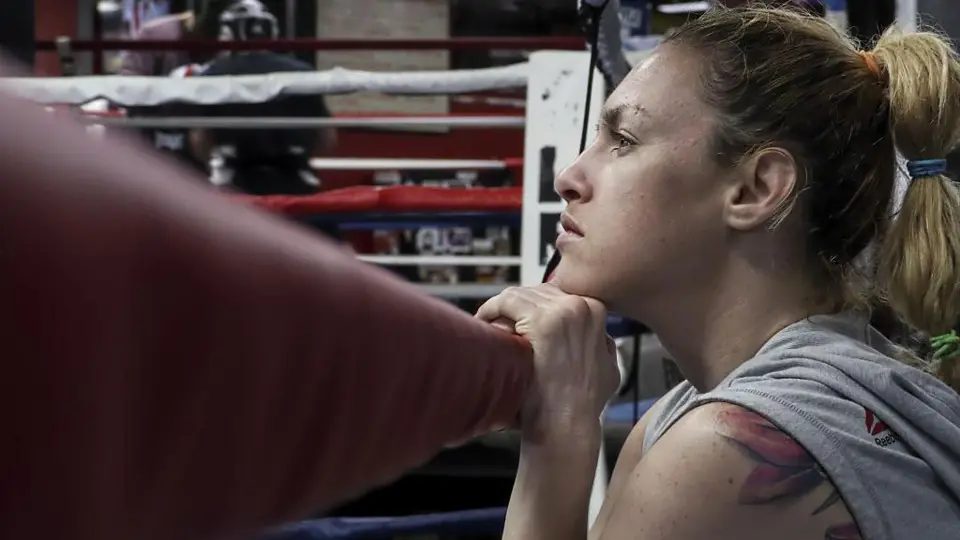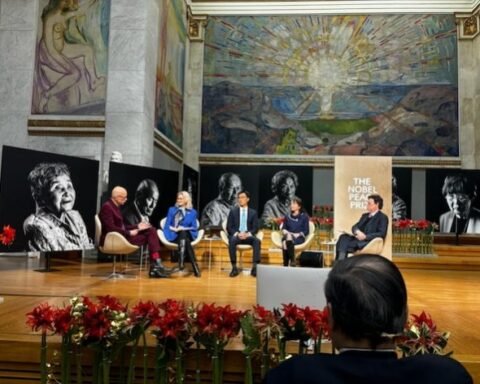With her left eye swollen shut and blood streaming down her forehead, Heather Hardy stood resolute in the ring, her fierce spirit undeterred by the brutality of the bout. The ringside doctor advised her to reconsider, but Hardy’s response was unwavering. “I want to continue,” she declared, her voice echoing with determination.
As she strode back to the center of the ring, she thumped her chest and shouted, “I don’t care, I don’t care.” The near 20,000-strong crowd at the American Airlines Center in Texas erupted into a roaring cheer, recognizing the indomitable warrior before them. It was a moment of gladiatorial defiance—exactly what Hardy had always embodied.
At 42 years old, Hardy was not about to change the habit of a lifetime, especially in the final minutes of her bout against Amanda Serrano, the undisputed featherweight champion. The two fighters met at the center of the ring, touching gloves before launching back into frantic action, trading heavy blows for the last 15 seconds of the penultimate round. When the round ended, Hardy returned to her corner, once again beating her chest and soaking in the electric atmosphere.

As the final round commenced, both fighters unleashed everything they had left until the bell rang, signaling the end of the contest. They embraced in a show of mutual respect, but as the blood was wiped from Hardy’s face, the outcome became clear. Ring announcer Jimmy Lennon Jr. prepared to confirm the result: Serrano had won by a unanimous decision. There were no surprises or protests from Hardy; she knew Serrano had landed nearly twice as many punches, and this was just another testament to her gritty spirit.
That night on August 5, 2023, marked Hardy’s last competitive appearance in the ring. Reflecting on the bout, she later told BBC Sport, “I came out of the ring, got home, and I had double vision. I had the usual concussion stuff, but when the double vision didn’t go away the next day, I knew something was wrong.” She adjusted to the reality of her condition, believing that, like any injury, she could just train through it.
However, a year after that defeat, instead of enjoying the fruits of her labor, Hardy found herself grappling with utility bills and financial struggles. “My lights are getting ready to get shut off,” she lamented, contrasting her situation with that of other former champions. “I bet you Shawn Porter doesn’t have that problem.”
Though both Hardy and Porter had once shared a card at the Barclays Center in 2016, their financial realities were starkly different. “I had this beautiful career, but it feels like they just pushed me back outside the fence and said, ‘Be happy you had the chance, Heather. It was nice, but go figure it out yourself.’”
In the months following her fight with Serrano, Hardy was forced to confront her declining health. Symptoms of chronic traumatic encephalopathy (CTE) emerged—persistent headaches, double vision, and an inability to sleep. CTE is a degenerative brain condition linked to repeated head trauma, and Hardy had begun to understand its implications. “Every time you get a concussion, a piece of your brain dies,” she explained. “Over the years, I’ve lost so much of my brain that I can’t afford to lose anything else.”
The external wounds of her boxing career had healed, but the internal scars remained. As she reflected on her sudden retirement, Hardy spoke of the emotional toll it took. “That was days of crying, trying to understand, because everything I ever did was to the max, and now I have to quit when it gets hard to save my life,” she said, her voice heavy with grief. “Wow, not fair. Give that to someone else.”
Sitting at her kitchen table, surrounded by piles of boxing equipment, Hardy attempted to make light of her situation. Wearing heart-shaped glasses, she declared, “I can’t complain; I’m hanging in there and on the right side of the dirt.” Yet, beneath her lighthearted facade lay the weight of her career—what had she to show for over a decade of sacrifice?
“The last two months have been about bouncing back and learning to live like this,” she reflected. Daily trips to the gym, a routine that had defined her life for nearly two decades, were now impossible. Medical professionals had warned her that any further physical stress could have dire consequences. Even the simplest workouts now made her feel nauseous. “I passed out trying to jump rope,” she recalled, the disbelief still fresh in her mind.
Coaching at Gleason’s gym was another source of income that had slipped away due to her declining health. “It’s a hybrid feeling of high-five you made it out, but I still gave everything and I have nothing,” she confessed. “What is hard for me to grip is that I gave so much, and now I have to start over again.”
Hardy’s journey into boxing was far from conventional. She had graduated from John Jay College of Criminal Justice with a degree in forensic psychology and once idolized the late Supreme Court Justice Ruth Bader Ginsburg. But the world of boxing opened up for her when she first stepped into a gym in 2010, seeking a break from the daily grind as a single mother juggling multiple jobs.
By April 2011, just months after her initial foray into the sport, Hardy had become the US national featherweight champion. She made her professional debut in 2012 and quickly went on a six-year unbeaten streak, ultimately claiming the WBO featherweight title at Madison Square Garden. Alongside her boxing career, she ventured into mixed martial arts, competing four times under the Bellator banner.
Despite her successes, Hardy faced personal challenges few could imagine, battling issues ranging from hurricanes to homelessness. Yet she remained resilient, attributing her strength to her faith and a steadfast belief in perseverance. “I’m sitting here because I have faith in God and I’ve walked with him this entire path,” she explained, emphasizing the importance of integrity and determination.
As a prominent advocate for gender equality in sports, Hardy has long raised her voice against the pay disparities women face in boxing. Despite her profile, she often found herself selling her own tickets just to ensure financial stability after fights. “Women are making 80 cents to the dollar; the pay gap in female sports is absurd,” she lamented. “Ten years ago, you’d think it was 1974. It will change because of women like me who won’t shut up.”
Though female fighters have gained more visibility and opportunities in recent years, Hardy believes the financial compensation hasn’t improved accordingly. “They’re being put in the best spots on the show and being paid a fraction of what that spot is worth,” she asserted, determined to continue fighting for equality.
With a legacy shaped by strong women in her family, including her great-grandmother, one of the first female firefighters in the U.S., and her mother, who volunteered in the fire department, Hardy is driven to lead the charge for change. “We don’t look back; we will walk through fire. I am my mother’s savage daughter,” she proudly declared.
As one chapter of her life closed, Hardy was already looking ahead, contemplating a new path as she pursued her manager’s license. When asked to recall a highlight from her career, her eyes sparkled with nostalgia. “When I made my MMA debut and knocked out the girl, I fell to my knees and thought, ‘Billy Joel sits here, and they are singing my name,’” she reminisced, a smile breaking through the weight of her circumstances. “I never let go of that.”







